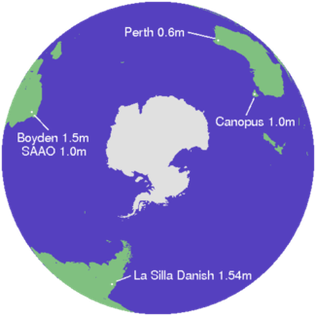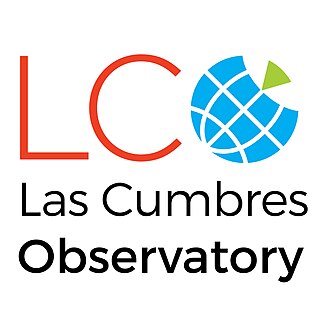
The Southern African Large Telescope (SALT) is a 9.2-metre optical telescope designed mainly for spectroscopy. It consists of 91 hexagonal mirror segments each with a 1-metre inscribed diameter, resulting in a total hexagonal mirror of 11.1 by 9.8 m. However, its effective aperture is only 9.2 m. It is located close to the town of Sutherland in the semi-desert region of the Karoo, South Africa. It is a facility of the South African Astronomical Observatory, the national optical observatory of South Africa.

The Apache Point Observatory is an astronomical observatory located in the Sacramento Mountains in Sunspot, New Mexico, United States, approximately 18 miles (29 km) south of Cloudcroft. The observatory is operated by New Mexico State University (NMSU) and owned by the Astrophysical Research Consortium (ARC). Access to the telescopes and buildings is private and restricted.

The Cerro Tololo Inter-American Observatory (CTIO) is an astronomical observatory located on the summit of Mt. Cerro Tololo in the Coquimbo Region of northern Chile, with additional facilities located on Mt. Cerro Pachón about 10 kilometres (6.2 mi) to the southeast. It is approximately 80 kilometres (50 mi) east of La Serena, where support facilities are located. The principal telescopes at CTIO are the 4 m Víctor M. Blanco Telescope, named after Puerto Rican astronomer Víctor Manuel Blanco, and the 4.1 m Southern Astrophysical Research Telescope, which is situated on Cerro Pachón. Other telescopes on Cerro Tololo include the 1.5 m, 1.3 m, 1.0 m, and 0.9 m telescopes operated by the SMARTS consortium. CTIO also hosts other research projects, such as PROMPT, WHAM, and LCOGTN, providing a platform for access to the southern hemisphere for U.S. and worldwide scientific research.

University of Canterbury Mount John Observatory (UCMJO), previously known as Mt John University Observatory (MJUO), is New Zealand's premier astronomical research observatory. It is situated at 1,029 metres (3,376 ft) ASL atop Mount John at the northern end of the Mackenzie Basin in the South Island, and was established in 1965. There are many telescopes on site including: one 0.4 metre, two 0.6 metre, one 1.0 metre, and a 1.8 metre MOA telescope. The nearest population centre is the resort town of Lake Tekapo (pop. >500). Approximately 20% of nights at UCMJO are photometric, with a larger number available for spectroscopic work and direct imaging photometry.
William Stephen FinsenFRAS was a South African astronomer. He discovered a number of double stars and took many photographs of Mars. He developed the Finsen eyepiece interferometer to measure very close double stars. He was the final director of Union Observatory in South Africa from 1957 to 1965.

Siding Spring Observatory near Coonabarabran, New South Wales, Australia, part of the Research School of Astronomy & Astrophysics (RSAA) at the Australian National University (ANU), incorporates the Anglo-Australian Telescope along with a collection of other telescopes owned by the Australian National University, the University of New South Wales, and other institutions. The observatory is situated 1,165 metres (3,822 ft) above sea level in the Warrumbungle National Park on Mount Woorat, also known as Siding Spring Mountain. Siding Spring Observatory is owned by the Australian National University (ANU) and is part of the Mount Stromlo and Siding Spring Observatories research school.

WASP or Wide Angle Search for Planets is an international consortium of several academic organisations performing an ultra-wide angle search for exoplanets using transit photometry. The array of robotic telescopes aims to survey the entire sky, simultaneously monitoring many thousands of stars at an apparent visual magnitude from about 7 to 13.

Sutherland is a town with about 2,841 inhabitants in the Northern Cape province of South Africa. It lies in the western Roggeveld Mountains in the Karoo.

The Probing Lensing Anomalies NETwork (PLANET) collaboration coordinates a network of telescopes to rapidly sample photometric measurements of the magnification of stars in the galactic bulge undergoing gravitational microlensing by intervening foreground stars. This network consists of five 1m-class optical telescopes distributed in longitude around the southern hemisphere in order to perform quasi-continuous round-the-clock precision monitoring. On a target-of-opportunity basis, less frequent spectroscopic measurements complement the rapid photometry for selected prime targets. Since 2005, PLANET performs a common microlensing campaign with RoboNet-1.0, a network of UK-operated 2.0m robotic telescopes.

Las Cumbres Observatory (LCO) is a network of astronomical observatories run by a non-profit private operating foundation directed by the technologist Wayne Rosing. Its offices are in Goleta, California. The telescopes are located at both northern and southern hemisphere sites distributed in longitude around the Earth. For some astronomical objects, the longitudinal spacing of telescopes allows continuous observations over 24 hours or longer. The operating network currently consists of two 2 meter telescopes, nine 1 meter telescopes, and seven 40 cm telescopes, placed at six astronomical observatories. The network operates as a single, integrated, observing facility, using a software scheduler that continuously optimizes the planned observing schedule of each individual telescope.

Grubb Parsons was a historic manufacturer of telescopes, active in the 19th and 20th centuries. They built numerous large research telescopes, including several that were the largest in the world of their type.

MOA-2009-BLG-387L is a red dwarf in the Sagittarius constellation that is host to the planet MOA-2009-BLG-387Lb. The star is estimated to be nearly 20,000 light years away and approximately one fifth the mass of the Sun, although large confidence intervals exist, reflecting the uncertainties in both the mass and distance. The star drew the attention of astronomers when it became the lens of gravitational microlensing event MOA-2009-BLG-387L, in which it eclipsed a background star and created distorted caustics, an envelope of reflected or refracted light rays. Analysis of the caustic events and of follow-up observational data led to the planet's discovery, which was reported in February 2011.
The Kilodegree Extremely Little Telescope is an astronomical observation system formed by two robotic telescopes that are conducting a survey for transiting exoplanets around bright stars. The project is jointly administered by members of Ohio State University Department of Astronomy, the Vanderbilt University Department of Physics and Astronomy Astronomy Group, the Lehigh University Department of Physics, and the South African Astronomical Observatory (SAAO).
Ian Stewart Glass is an infrared astronomer and scientific historian living in Cape Town, South Africa.

Time-domain astronomy is the study of how astronomical objects change with time. Though the study may be said to begin with Galileo's Letters on Sunspots, the term now refers especially to variable objects beyond the Solar System. Changes over time may be due to movements or changes in the object itself. Common targets included are supernovae, pulsating stars, novas, flare stars, blazars and active galactic nuclei. Visible light time domain studies include OGLE, HAT-South, PanSTARRS, SkyMapper, ASAS, WASP, CRTS, GOTO and in a near future the LSST at the Vera C. Rubin Observatory.

The Royal Observatory, Cape of Good Hope, is a former scientific institution in South Africa. Founded by the British Board of Longitude in 1820, its main building is now the headquarters building of the South African Astronomical Observatory.
The SAAO Library is the national library of the South African Astronomical Observatory (SAAO) for astronomy and space science located in Observatory, Cape Town, South Africa. Its primary function is to conduct fundamental research in astronomy and astrophysics. The SAAO library can be seen as the integral part of the facility as it provides the research staff with access to essential information and tools that allow them to function as informed professionals within their community.

The Next-Generation Transit Survey (NGTS) is a ground-based robotic search for exoplanets. The facility is located at Paranal Observatory in the Atacama Desert in northern Chile, about 2 km from ESO's Very Large Telescope and 0.5 km from the VISTA Survey Telescope. Science operations began in early 2015. The astronomical survey is managed by a consortium of seven European universities and other academic institutions from Chile, Germany, Switzerland, and the United Kingdom. Prototypes of the array were tested in 2009 and 2010 on La Palma, and from 2012 to 2014 at Geneva Observatory.

The Radcliffe Telescope is a 74 in (1.9 m) optical/near-infrared reflecting telescope located at the South African Astronomical Observatory in Sutherland, Northern Cape, South Africa.



























